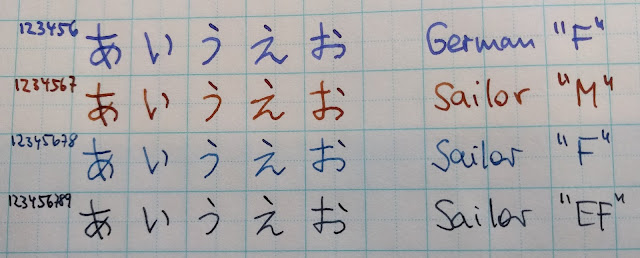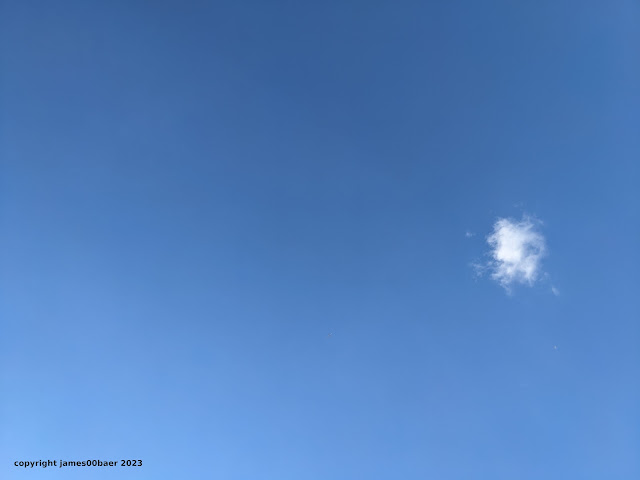Writing Kanji and suitable pens and paper
So you decided to learn Japanese?
Good idea. May I give you some small tips and tricks over the next few weeks? They are not really ordered but important nevertheless. The best is you subscribe to this blog or you come back sometimes and click on the tag link "Learning Japanese".
Writing Kanji needs a lot of training. You need to write, write, write. You must learn the order in which a Kanji is written and you must develop a feeling what looks good and what doesn't. So again my recommendation: "you need to write, write, write".
Kanji can contain many strokes - really many - up to more than 30 even. Admittedly, the higher the number, the less they are in use - but still, you will have to learn to write Kanji with 20 strokes or more. If you write with a really broad pen, you cannot write Kanjis which are clear and which show distinguishable strokes. So you better choose a pen which writes (extra)fine lines.
Personally, I like to use fountain pens. And for writing Kanji I recommend pens with a nib size of EF. In the photo below I have shown a comparison of different nib sizes and the outcome.
Be aware that the nib sizes depend on which pen maker you choose. It is known that European and US fountain pens have bigger nib sizes despite the same code. So, a German "F" is much bigger than a Japanese "F", even sometimes bigger than a Japanese "M". You can see this in the square with the numbers. With that German "F" nib, I can fit in the numbers 1-6, with the Japanese "F" 1-8, with the Japanese "EF", I even fit in 1-9.
Never, ever, choose a European M or a B nib. With such a nib you can paint walls but never write clearly readable Kanji characters.
So - which (fountain) pen should I choose?
Which maker you choose does not only depend on the nib, but also on how you like the feeling of the pen. Personally, I prefer fountain pens of the maker Sailor. I like their cigar-shaped pens more than the torpedo-shaped Pilot pens. But other people prefer Pilot or Platinum or other makers.
The prices of Japanese fountain pens outside of Japan are not cheap. There are other cheaper possibilities, one I would like to mention.
Buy a Jinhao X450 or Jinhao X750 or Jinhao 159 - best price is usually on Aliexpress, especially if they have sales events. You then can get a suitable pen for 1 USD.
And then exchange the nib for another nib - e.g. a Jowo #6 "EF" which you can obtain here : LINK. (On that site, there are many more possible nibs.) But beware, their "EF" nibs are comparable to the Japanese "F" nibs. Sharpening to smaller nibs (they call it XXF or XXXF) is possible but costs additional money. But I think, the normal-priced "EF" is small enough for Kanji writing.
Depending on where you live, you can obtain a "Kanji-writing" pen for less than 20 USD. A good opportunity to start.
But, if you prefer, roller ball pens or mechanical pencils are also usable.
Something else to know for the start?
As you can see in the pictures above, I am using special squared paper which additionally has some help lines inside the squares. This helps developing a better feeling for the character and its build-up.
This paper is called "genkouyoushi (げんこうようし) or kanji practice writing paper". I am living in Japan, so I just buy it in a normal store or online. But there is also the possibility to print out such paper. Download links can be found e.g. on this site: LINK.
In the next few days, I will comment on books and recommend a necessary software for Kanji-learning - Anki.
Until then: good luck.
Good idea. May I give you some small tips and tricks over the next few weeks? They are not really ordered but important nevertheless. The best is you subscribe to this blog or you come back sometimes and click on the tag link "Learning Japanese".
Writing Kanji needs a lot of training. You need to write, write, write. You must learn the order in which a Kanji is written and you must develop a feeling what looks good and what doesn't. So again my recommendation: "you need to write, write, write".
Kanji can contain many strokes - really many - up to more than 30 even. Admittedly, the higher the number, the less they are in use - but still, you will have to learn to write Kanji with 20 strokes or more. If you write with a really broad pen, you cannot write Kanjis which are clear and which show distinguishable strokes. So you better choose a pen which writes (extra)fine lines.
Personally, I like to use fountain pens. And for writing Kanji I recommend pens with a nib size of EF. In the photo below I have shown a comparison of different nib sizes and the outcome.
 |
| Comparison of different nib sizes - shown with numbers and Hiragana |
Never, ever, choose a European M or a B nib. With such a nib you can paint walls but never write clearly readable Kanji characters.
 |
| Kanji written with Sailor "EF" and the German "F" |
Which maker you choose does not only depend on the nib, but also on how you like the feeling of the pen. Personally, I prefer fountain pens of the maker Sailor. I like their cigar-shaped pens more than the torpedo-shaped Pilot pens. But other people prefer Pilot or Platinum or other makers.
The prices of Japanese fountain pens outside of Japan are not cheap. There are other cheaper possibilities, one I would like to mention.
Buy a Jinhao X450 or Jinhao X750 or Jinhao 159 - best price is usually on Aliexpress, especially if they have sales events. You then can get a suitable pen for 1 USD.
And then exchange the nib for another nib - e.g. a Jowo #6 "EF" which you can obtain here : LINK. (On that site, there are many more possible nibs.) But beware, their "EF" nibs are comparable to the Japanese "F" nibs. Sharpening to smaller nibs (they call it XXF or XXXF) is possible but costs additional money. But I think, the normal-priced "EF" is small enough for Kanji writing.
Depending on where you live, you can obtain a "Kanji-writing" pen for less than 20 USD. A good opportunity to start.
But, if you prefer, roller ball pens or mechanical pencils are also usable.
Something else to know for the start?
As you can see in the pictures above, I am using special squared paper which additionally has some help lines inside the squares. This helps developing a better feeling for the character and its build-up.
This paper is called "genkouyoushi (げんこうようし) or kanji practice writing paper". I am living in Japan, so I just buy it in a normal store or online. But there is also the possibility to print out such paper. Download links can be found e.g. on this site: LINK.
In the next few days, I will comment on books and recommend a necessary software for Kanji-learning - Anki.
Until then: good luck.


Comments
Post a Comment